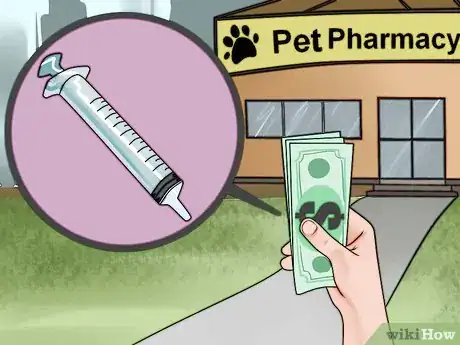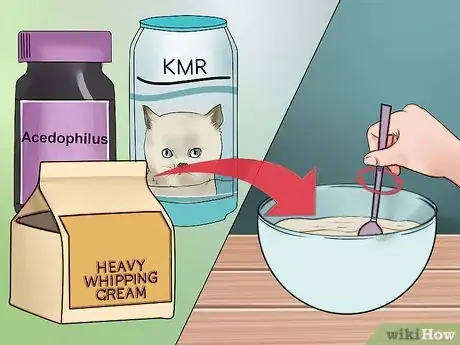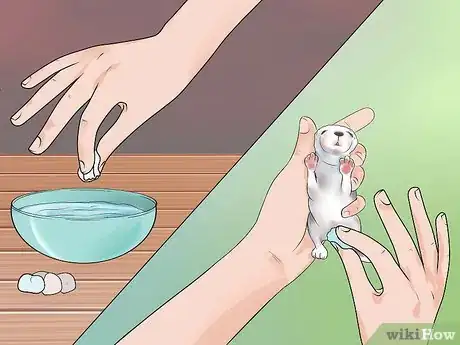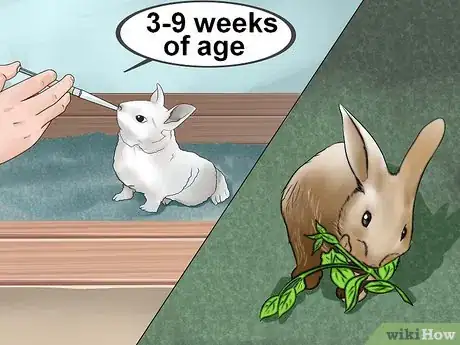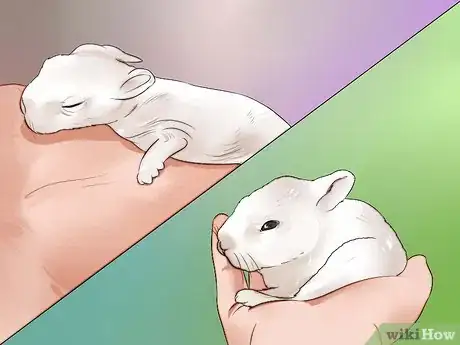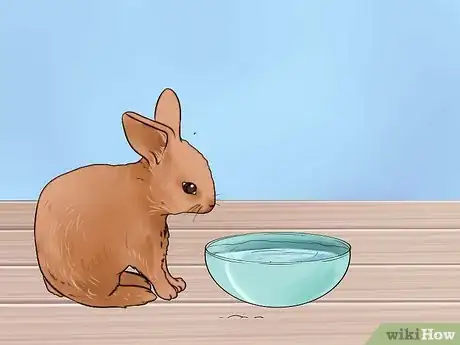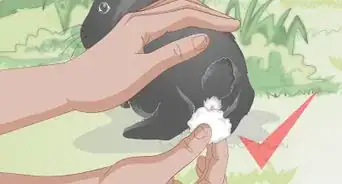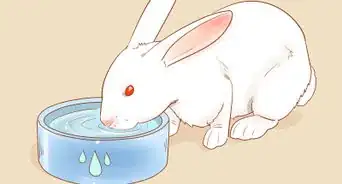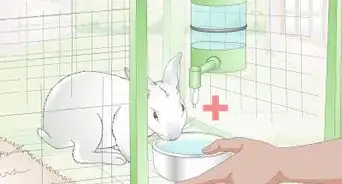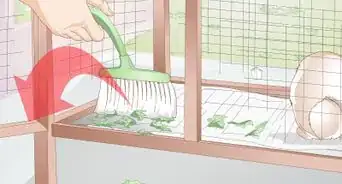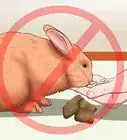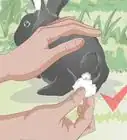This article was co-authored by Pippa Elliott, MRCVS. Dr. Elliott, BVMS, MRCVS is a veterinarian with over 30 years of experience in veterinary surgery and companion animal practice. She graduated from the University of Glasgow in 1987 with a degree in veterinary medicine and surgery. She has worked at the same animal clinic in her hometown for over 20 years.
wikiHow marks an article as reader-approved once it receives enough positive feedback. This article received 11 testimonials and 90% of readers who voted found it helpful, earning it our reader-approved status.
This article has been viewed 580,381 times.
Baby rabbits are small, sweet and furry animals that can require a lot of care. Whether you find a nest of orphaned babies, which are also called kittens, or your pet rabbit has rejected her babies, you may need to feed the rabbits to help them thrive. By feeding at appropriate times of the day and the proper amount and type of food, you can help baby rabbits have a good start to life.
Steps
Feeding Baby Rabbits Formula
-
1Confirm that the mother is not feeding the kittens. Before you take a baby rabbit away from its mother or think it’s orphaned, make sure the mother is not feeding it or that she is a risk to the kitten. Mother rabbits feed their kittens about twice a day and only for five minutes. The babies also do not need the mother to keep them warm. If the babies do not seem distressed, even if the mother is away from them a lot, the mother is likely just taking a break and you should not interfere.[1]
- Neglected baby rabbits are cold, cry for more than a few minutes at feeding time, are blue, or their skin is shriveled from dehydration.[2]
- Some mothers may reject their babies, and in these cases you should separate the babies from her so that she doesn’t harm them.[3]
- Don’t assume an unattended nest of wild baby rabbits is orphaned. Check on them frequently before you take them in to feed them. If they seem content, it is unlikely that they have been abandoned.[4]
- Only 10% of hand-reared rabbits survive, so it is better to leave them in the wild whenever possible.
-
2Purchase replacement milk for the baby rabbits. If you are going to feed baby rabbits, you’ll need to purchase replacement milk for them. Rabbit milk is the most caloric of all mammals’ milk, so you’ll need to make sure you get the proper replacement and amounts.[5]
- Buy Kitten Milk Replacer (KMR) or goat milk to feed the babies. You can purchase these at pet stores or sometimes at a local vet’s office.[6]
- You can supplement each can of KMR with one tablespoon of sugar-free 100% heavy whipping cream to increase the calories and mimic the rich mother’s milk.[7]
- You can also supplement the KMR by adding a bit of acidophilus to the formula. This can help baby rabbits maintain healthy intestinal bacteria.[8] Acidophilus is available at most health food stores.[9]
Advertisement -
3Buy syringes or eyedroppers for feedings. Baby rabbits won’t usually eat from a bottle, so make sure to have some sterile oral syringes or eyedroppers on hand to feed them. This will help you control the amount the kittens eat and help mimic the size of a mother’s nipple.[10]
- You can buy oral syringes or eyedroppers at most pharmacies. Vet’s offices and pet stores may also have special options for pets.
-
4Mix the replacement milk formula. Baby rabbits will nurse from birth until they are about 6 weeks old, and you’ll need to mix enough formula to feed them at different ages. By splitting the formula into two equal feedings a day, you can help ensure your baby rabbit is getting sufficient nutrition.[11]
- Remember to mix one tablespoon of 100% sugar-free heavy whipping cream with each can of Kitten Replacement Milk.[12] You can also add the pinch acidophilus at this time, too.
- Newborn rabbits up to a week old get 4 – 5 cc formula.[13]
- Rabbits that are 1 – 2 weeks old get 10 – 15 cc formula.[14]
- Rabbits that are 2 – 3 weeks old get 15 – 30 cc formula.[15]
- Rabbits that are 3 – 6 weeks old or until they are weaned get 30 cc formula.[16]
-
5Give the baby rabbit its formula. Once you’ve mixed the formula, you can nurse your baby rabbit twice a day. It’s important to feed them similarly to how they feed from their mothers to help them stay healthy and grow.[17]
- Mother rabbits generally feed their babies twice a day — at dawn and at dusk.[18]
-
6Allow the kitten to eat at its own pace. It’s essential that you let baby rabbits to feed at their own speed. Not doing so can suffocate or kill the kitten.[19]
- The baby may suckle the syringe and you can gently squirt a small amount of formula as they want it.[20]
- If the baby isn’t suckling the syringe willingly, give it time to adjust. You might want to stimulate the kitten with a gentle squirt.[21]
- You may also want to pet your baby rabbit while feeding her for comfort.
-
7Stimulate defecation and urination. It’s crucial that baby rabbits defecate and urinate either before or after each feeding. This helps keep their intestinal tract and urinary system healthy and running smoothly.[22]
- You only need to stimulate defecation and urination for the first 10 days of a baby rabbit’s life, or until their eyes are open.[23]
- Use a cotton ball moistened with warm water and gently stroke the anal and genital area of the baby rabbit until it starts defecating and urinating. Continue this until the kitten is finished.[24]
- Don’t worry that you’re doing something wrong, this mimics the same behavior a mother rabbit would do.[25]
-
8Wean your baby rabbits. Continue to feed your baby rabbit formula and solids until she is ready to wean. Depending on what type of rabbit you have, she will wean at anywhere from 3 – 4 weeks of age to 9 weeks of age.[26]
Feeding Baby Rabbits Solid Foods
-
1Wait until the baby's eyes are open. Baby rabbits may begin eating solid foods when their eyes open, at about 10 days after birth. You can slowly add solid foods to their formula diet until they are weaned at about 6 weeks old. Don’t feed baby rabbits solid foods before their eyes open. Their intestinal tracts cannot handle solids before this point.[29]
-
2Introduce solid food. Once your rabbit's eyes are open, you can start incorporating solid food into its diet. However, domestic and wild rabbits feed on different solids, so know what kind of rabbit you have. Both can eat oat and timothy hay and alfalfa hay; domestic can also eat pellets; wild can also eat vegetables.[30]
- Domestic rabbits: oat and timothy hay; alfalfa hay; pellets. Do NOT give them vegetables.
- Wild rabbits: oat and timothy hay; alfalfa hay; fresh vegetables like dark leafy greens, carrot tops, parsley. Do NOT give them pellets.
- Leave the solids in the corner of their box where they can easily eat them.[31]
- Make sure to change hay, pellets, and vegetables often so that they don’t go bad and harbor bacteria. The vegetables should be fresh and moist.[32]
- You can buy hay and pellets at most pet stores or a vet’s office. Greens and carrots are readily available at grocery stores or farmer’s markets.
-
3Provide water for baby rabbits. In addition to formula and solid foods, consider giving your baby rabbits water. This can help keep them hydrated and feeding properly.[33]
- Don’t leave a deep dish in the box. Baby bunnies can drown in deep dishes filled with water.[34]
- Fill a shallow dish with a small amount of water and place it in the corner of the box.[35]
- Clean and refill the water dish frequently. This can not only help your baby rabbits stay hydrated, but can also help ensure that the water doesn’t harbor any bacteria.[36]
Warnings
- Never feed the rabbit his liquid food too fast through the syringe.⧼thumbs_response⧽
- Do not underfeed or overfeed your rabbit.⧼thumbs_response⧽
Things You'll Need
- Syringe or eyedropper
- Baby rabbit feed from your vet
- Kitten Replacement Milk or goat’s milk
- Fresh cream (optional)
References
- ↑ http://www.humanesociety.org/animals/rabbits/tips/solving_problems_rabbits.html
- ↑ http://www.mybunny.org/info/caring-for-newborn-baby-rabbits/
- ↑ http://www.mybunny.org/info/caring-for-newborn-baby-rabbits/
- ↑ http://www.humanesociety.org/animals/rabbits/tips/solving_problems_rabbits.html
- ↑ http://www.mybunny.org/info/caring-for-newborn-baby-rabbits/
- ↑ http://www.mybunny.org/info/caring-for-newborn-baby-rabbits/
- ↑ http://www.mybunny.org/info/caring-for-newborn-baby-rabbits/
- ↑ http://www.mybunny.org/info/caring-for-newborn-baby-rabbits/
- ↑ http://www.mybunny.org/info/caring-for-newborn-baby-rabbits/
- ↑ http://www.mybunny.org/info/caring-for-newborn-baby-rabbits/
- ↑ http://www.mybunny.org/info/caring-for-newborn-baby-rabbits/
- ↑ http://www.mybunny.org/info/caring-for-newborn-baby-rabbits/
- ↑ http://www.mybunny.org/info/caring-for-newborn-baby-rabbits/
- ↑ http://www.mybunny.org/info/caring-for-newborn-baby-rabbits/
- ↑ http://www.mybunny.org/info/caring-for-newborn-baby-rabbits/
- ↑ http://www.mybunny.org/info/caring-for-newborn-baby-rabbits/
- ↑ http://www.humanesociety.org/animals/rabbits/tips/solving_problems_rabbits.html
- ↑ http://www.humanesociety.org/animals/rabbits/tips/solving_problems_rabbits.html
- ↑ http://www.mybunny.org/info/caring-for-newborn-baby-rabbits/
- ↑ http://www.mybunny.org/info/caring-for-newborn-baby-rabbits/
- ↑ http://www.mybunny.org/info/caring-for-newborn-baby-rabbits/
- ↑ http://www.rabbit.org/care/orphan.html
- ↑ http://www.rabbit.org/care/orphan.html
- ↑ http://www.rabbit.org/care/orphan.html
- ↑ http://www.rabbit.org/care/orphan.html
- ↑ http://www.rabbit.org/care/orphan.html
- ↑ http://www.rabbit.org/care/orphan.html
- ↑ http://www.rabbit.org/care/orphan.html
- ↑ http://www.rabbit.org/care/orphan.html
- ↑ http://www.rabbit.org/care/orphan.html
- ↑ http://www.rabbit.org/care/orphan.html
- ↑ http://www.rabbit.org/care/orphan.html
- ↑ http://www.mybunny.org/info/caring-for-newborn-baby-rabbits/
- ↑ http://www.mybunny.org/info/caring-for-newborn-baby-rabbits/
- ↑ http://www.mybunny.org/info/caring-for-newborn-baby-rabbits/
- ↑ http://www.mybunny.org/info/caring-for-newborn-baby-rabbits/
About This Article
To feed your baby rabbit for the first 6 weeks of its life, buy Kitten Milk Replacer and add 1 tablespoon of heavy whipping cream to each can, since rabbit milk is naturally high in calories. Use a syringe or eye dropper to feed your baby rabbit twice a day. Give it 5 cc’s of formula at each feeding the first week, 10-15 cc’s the second week, and 15-30 cc’s after that. When your baby rabbit’s eyes are open, you can feed it solid foods, too. Start by giving it oat, timothy hay, and alfalfa hay, which all rabbits can eat. For information from our Veterinary reviewer how to feed domestic and wild baby rabbits differently, read on!


